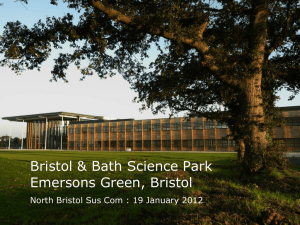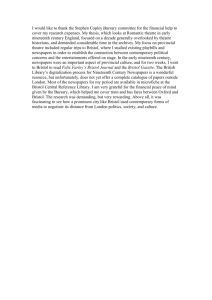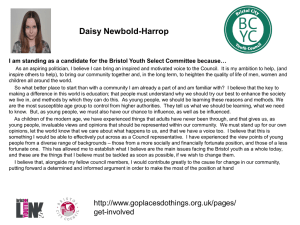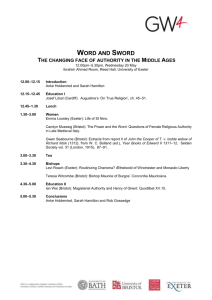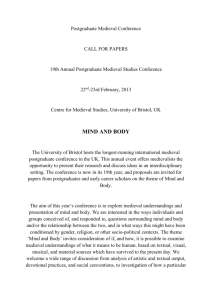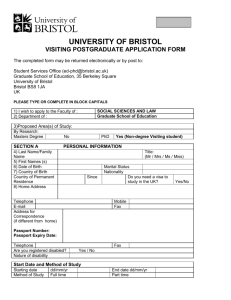Teacher Notes - DTT Medieval Mig
advertisement
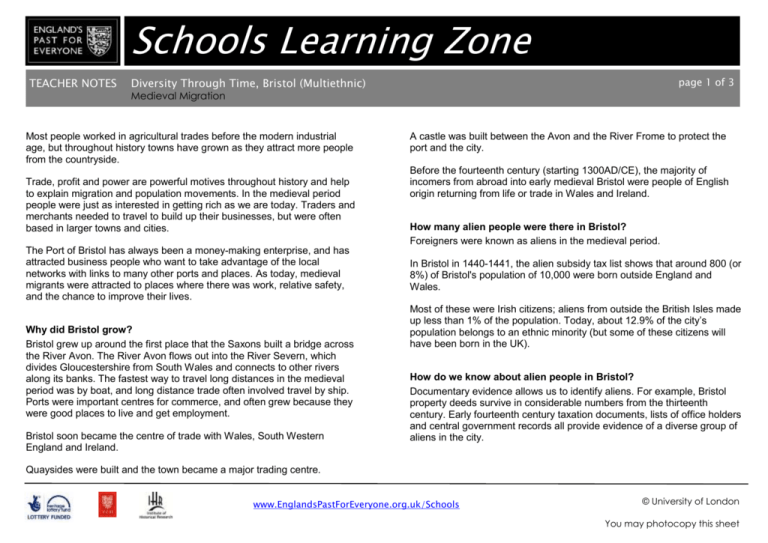
Schools Learning Zone TEACHER NOTES page 1 of 3 Diversity Through Time, Bristol (Multiethnic) Medieval Migration Most people worked in agricultural trades before the modern industrial age, but throughout history towns have grown as they attract more people from the countryside. Trade, profit and power are powerful motives throughout history and help to explain migration and population movements. In the medieval period people were just as interested in getting rich as we are today. Traders and merchants needed to travel to build up their businesses, but were often based in larger towns and cities. The Port of Bristol has always been a money-making enterprise, and has attracted business people who want to take advantage of the local networks with links to many other ports and places. As today, medieval migrants were attracted to places where there was work, relative safety, and the chance to improve their lives. Why did Bristol grow? Bristol grew up around the first place that the Saxons built a bridge across the River Avon. The River Avon flows out into the River Severn, which divides Gloucestershire from South Wales and connects to other rivers along its banks. The fastest way to travel long distances in the medieval period was by boat, and long distance trade often involved travel by ship. Ports were important centres for commerce, and often grew because they were good places to live and get employment. Bristol soon became the centre of trade with Wales, South Western England and Ireland. A castle was built between the Avon and the River Frome to protect the port and the city. Before the fourteenth century (starting 1300AD/CE), the majority of incomers from abroad into early medieval Bristol were people of English origin returning from life or trade in Wales and Ireland. How many alien people were there in Bristol? Foreigners were known as aliens in the medieval period. In Bristol in 1440-1441, the alien subsidy tax list shows that around 800 (or 8%) of Bristol's population of 10,000 were born outside England and Wales. Most of these were Irish citizens; aliens from outside the British Isles made up less than 1% of the population. Today, about 12.9% of the city’s population belongs to an ethnic minority (but some of these citizens will have been born in the UK). How do we know about alien people in Bristol? Documentary evidence allows us to identify aliens. For example, Bristol property deeds survive in considerable numbers from the thirteenth century. Early fourteenth century taxation documents, lists of office holders and central government records all provide evidence of a diverse group of aliens in the city. Quaysides were built and the town became a major trading centre. www.EnglandsPastForEveryone.org.uk/Schools © University of London You may photocopy this sheet TEACHER NOTES page 2 of 3 Diversity Through Time, Bristol (Multiethnic) Medieval Migration The origins of some people can be identified by toponymic surnames – names that denote a place or region of origin, for example John le Lung (Long) de Kerdyff (Cardiff) merchant of Bristol. Why were there close trade links with Wales? Wales is only a few miles away from Bristol, down the Avon and across the Severn estuary. The River Wye flows into the Severn and passes through Newport and Chepstow, before travelling for miles along the English-Welsh borderlands. These rivers provided an easily navigable trade route and allowed strong trade links to be established between Bristol and Wales. Historians are able to prove that from the later fourteenth century, a group of Welsh merchants and traders were actively doing business with Bristolians. Some were living in the city and seem to have been accepted into local life. Historians tell us that this comfortable and profitable relationship was unusual for the time. Elsewhere, conflict between the Welsh princes and the English kings led to prejudices, and there was discrimination against the Welsh in other border towns. At the same time, conflicts in Ireland meant a stream of Anglo-Irish economic or political refugees were making their way to Bristol. This is likely to have been a cause of friction as people competed for jobs and resources. Prejudice against the Irish seems to have been stronger than against the Welsh. Who was forced to come to Bristol? From the 1430s to the 1470s, Bristol was heavily involved in trade with Iceland, selling goods to Icelanders, and buying or kidnapping children as cheap labour. The 1440-41 Alien Subsidy Returns shows that the single largest group of aliens in Bristol was Icelanders, all of whom only have first names listed, for example: 'Snorry Iseland', 'Helgy Iseland', 'Haraldus Iseland'. They were probably servants and low-paid workers. The Alien Return of 1484 lists 49 Icelandic servants. In 1462 the Bristol Weavers' Guild complained that many weavers: “… daily receive and put in occupation of the said craft strangers, aliens, and others … and for their singular profit, provoke and stir diverse merchants and others to bring into this town of Bristol people of diverse countries not born under the king’s allegiance but rebellious, which be sold to them as it were heathen people, and through the continuance thereof in default of correction it has caused that such strangers and aliens be greatly multiplied and increased within the town of Bristol, and that the king’s liege people born within this said town and other parts of this his realm be vagrants and unoccupied, and may not have their labour for their living …” How did people react to the alien Invasion? Mostly people tolerated aliens because they could see that they were just ordinary people trying to earn a living. However, when times were hard and there was little work or food, aliens were often an easy target for prejudice and violence. Aliens were often easy to spot and minorities are an easy scapegoat because they are distinctive and fewer in number. Some groups blend into the majority population more easily than others- they look similar and only language or accent, dialect or customs give them away. Whereas other groups stand out more easily because their facial features or ethnicity stand out and suggest they are different. www.EnglandsPastForEveryone.org.uk/Schools © University of London You may photocopy this sheet TEACHER NOTES Diversity Through Time, Bristol (Multiethnic) page 3 of 3 Medieval Migration In the past, people were unsure if they could trust strangers and aliens, and at best they were tolerated. Frequently they were discriminated against, and sometimes they were persecuted. www.EnglandsPastForEveryone.org.uk/Schools © University of London You may photocopy this sheet

